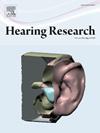Associations between physiological indicators of cochlear deafferentation and listening effort in military Veterans with normal audiograms
IF 2.5
2区 医学
Q1 AUDIOLOGY & SPEECH-LANGUAGE PATHOLOGY
引用次数: 0
Abstract
Cochlear synaptopathy, a type of cochlear deafferentation that impacts the synapses between the inner hair cells and the afferent auditory nerve fibers, is predicted to result in speech perception in noise difficulty. However, this has been difficult to confirm due to mixed findings in human studies of the relationship between speech perception in noise and physiological indicators of deafferentation (auditory brainstem response [ABR] wave I amplitude, envelope following response [EFR] magnitude, and middle ear muscle reflex [MEMR] magnitude). One possible explanation for the mixed findings is that some listeners with cochlear deafferentation can increase their cognitive effort to compensate for the degraded speech signal so that their speech-in-noise performance is relatively unaffected, obscuring the relationship between deafferentation and speech-in-noise scores.
In a population at high risk for noise-induced cochlear deafferentation (military Veterans with normal audiograms), this study evaluated the relationship between physiological indicators of deafferentation (ABR, EFR, and MEMR) and listening effort, as indicated by pupil dilation during a speech-in-noise task.
Mean reductions in ABR, EFR, and MEMR magnitude were associated with greater task-related pupil dilation, but not with reduced speech-in-noise performance, although only the ABR was statistically significant after accounting for sex and outer hair cell function. This suggests that cochlear deafferentation may result in increased listening effort during speech-in-noise perception, even if performance on the task is not negatively impacted. The observed relationship between EFR magnitude and pupil dilation was non-linear, suggesting that increased listening effort may only occur after a particular threshold level of deafferentation is reached.

听力图正常退伍军人耳蜗聋生理指标与听力的关系
耳蜗突触病(Cochlear synaptopopathy)是一种影响内耳毛细胞与传入听神经纤维之间的突触的耳蜗传入神经失传,预计会导致噪声困难的语音感知。然而,这一点很难得到证实,因为在人类研究中,噪音下的言语感知与脱传入神经生理指标(听觉脑干反应[ABR]波I振幅、包络反应[EFR]幅度和中耳肌肉反射[MEMR]幅度)之间的关系发现不一。对于这些混杂的发现,一个可能的解释是,一些耳蜗失传入的听者可以增加他们的认知努力来补偿退化的语音信号,因此他们的语音噪声表现相对不受影响,模糊了失传入和语音噪声评分之间的关系。在噪声诱发耳蜗聋的高危人群(听力图正常的退伍军人)中,本研究评估了耳蜗聋的生理指标(ABR、EFR和MEMR)与听力努力之间的关系,这是由在噪声任务中讲话时瞳孔扩张所显示的。ABR、EFR和MEMR大小的平均降低与任务相关的瞳孔扩大有关,但与噪音中言语表现的降低无关,尽管在考虑性别和外毛细胞功能后,只有ABR具有统计学意义。这表明,即使在任务上的表现没有受到负面影响,在噪音中感知语音时,耳蜗脱耳可能会导致听力努力的增加。观察到的EFR大小与瞳孔扩张之间的关系是非线性的,这表明听力努力的增加可能只有在达到特定的去传入阈值水平后才会发生。
本文章由计算机程序翻译,如有差异,请以英文原文为准。
求助全文
约1分钟内获得全文
求助全文
来源期刊

Hearing Research
医学-耳鼻喉科学
CiteScore
5.30
自引率
14.30%
发文量
163
审稿时长
75 days
期刊介绍:
The aim of the journal is to provide a forum for papers concerned with basic peripheral and central auditory mechanisms. Emphasis is on experimental and clinical studies, but theoretical and methodological papers will also be considered. The journal publishes original research papers, review and mini- review articles, rapid communications, method/protocol and perspective articles.
Papers submitted should deal with auditory anatomy, physiology, psychophysics, imaging, modeling and behavioural studies in animals and humans, as well as hearing aids and cochlear implants. Papers dealing with the vestibular system are also considered for publication. Papers on comparative aspects of hearing and on effects of drugs and environmental contaminants on hearing function will also be considered. Clinical papers will be accepted when they contribute to the understanding of normal and pathological hearing functions.
 求助内容:
求助内容: 应助结果提醒方式:
应助结果提醒方式:


